The wave towered over the stern, making me wonder how it could possibly not break into the cockpit testing our Passport 37’s cockpit designed to drain water quickly and not let the ocean over the lip of the companionway invading down below. Again and again, the gigantic waves approached the stern, towering for just a moment before sliding easily under the boat, lifting the stern and then sliding us into a trough between waves. But although one of the worst scares we’ve had cruising, this was a beautiful day, bright blue sky, warm and wonderful … if it hadn’t been for the 30 knot plus winds! It was our first, but not our last, experience with a significant high filling in behind a cold front. And after we gained more experience, we realized as scarey as the experience was for us as newer cruisers – this being our first overnight passage offshore – it wasn’t dangerous and actually alot of cruisers think of these as optimal conditions – the boat’s moving fast and as long as the waves aren’t impeding forward motion (i.e. the boat’s shuddering each time the bow plunges into yet another monster), it can be a good ride. So our first “storm” wasn’t a storm at all!
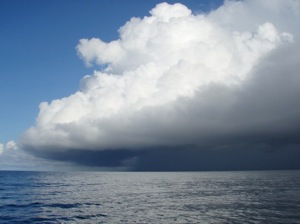
“What’s The WORST Storm You’ve Seen?” … this is probably the most asked question we get on our commuter cruising lifestyle. Most non-sailors don’t realize how intensely cruisers study multiple weather sources. Of course, that doesn’t stop Mother Nature from frequently surprising us. Aboard Winterlude, the longest passages we’ve made are 4 – 7 days. So we’re not out floating about the South Pacific for a month at a time on a crossing subjecting ourselves to whatever nature has to offer (or throw) at us.
Having said that, we have been in a couple of storms. Underway, we had scary storms on our first crossing from the Dry Tortugas/Florida Keys to Isla Mujeres, Mexico — but they were the product of the weather system the Gulf Stream generates. We didn’t realize that the Gulf Stream has it’s own weather system, so rather than cutting across at a 90 degree angle when the thunderstorms/squalls started, we sailed our original course putting us directly in line of squall lines one after another. The storms weren’t dangerous to experienced cruisers as evidenced by the log from our buddyboat, sv Handbasket (click on Handbasket to read Part I of Jim’s log of the crossing). But they were very scary for a new cruisers – big waves, water splashing in the cockpit, etc. We did learn how to use the radar to avoid the worst squall lines — and I coined the game “Dodge Squall” which we’ve used forever on every passage.
The usual on passage is just winds and waves from directions that were not forecast. But our passage from Colon, Panama to Providencia, Columbia ended with us running from the building seas and winds from developing Hurricane Ida. We were at anchor in Providencia by the time it actually hit 120 miles due west of us along the coastline of Nicaragua. We had two anchors down and the boat secured. Luckily the worst squall lines only had 30-35 mph winds. So we escaped again!
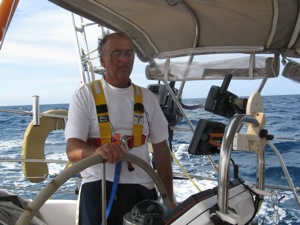
Many years earlier, while chartering in the Abacos, Bahamas, we were lucky enough to be enjoying a 10 day holiday when stubborn Hurricane Mitch decided to turn around and come back through the Keys and Bahamas. I’m sorry to say the charter company would not give us ANY advice when we called which seems like a very stupid way to do business with other people’s boats, but that’s another subject … We studied the chart and decided Hopetown Harbor looked like the most protected harbor in the vicinity. We sailed in, picked up a mooring and were standing on the bow trying to decide what next. Our thought was to deploy a 2nd anchor, but we had no practical experience. Luckily, the harbormaster came to our rescue, roaring up in his launch full of helpful advice. Good thing too because we were chartering for a much needed vacation and good time, not to learn anything about surviving a tropical storm, much less a hurricane! Winds blew 60 gusting to 75 with 3 foot chop in the harbor for several hours, the boat was bucking and straining, but we held with no problem other than me being a bit seasick – I don’t usually get seasick, I think it was as much nerves as true motion sickness!
After several hours blue sky appeared, the sun reappeared and the wind dropped to nothing. But the respite was quickly over and the other side of the eye resumed even more vicious than the initial round. The noise was deafening, that’s the thing I remember the most about the experience – other than my stomach in my throat all the time. The VHF radio crackled constantly with other boats needing help, inside the harbor only one big 40+ ft. powerboat broke loose and drifted through the fleet. We tried to catch it with our boathook but weren’t close enough. The trawler behind us did get a boathook on it, but the winds and chop were too much and it drifted on towards the rocks. Luckily BASRA (Bahamian Air Sea Rescue Rescue Association) came to the rescue, climbed aboard and saved the boat just as the rocks were beckoning. There was some damage in the harbor, although by far more damage came from other locations around the Abacos.
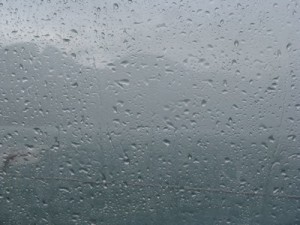
We were lucky but had learned some valuable lessons on storm management — inadvertently! The first lesson learned was that the ONLY boat in that harbor that broke loose was the one that refused the harbormaster’s assistance. Rule #1 — these guys generally know what they’re doing and it’s worthwhile to listen! 🙂 The following day dawned beautifully, not a cloud in the brilliant blue Bahamian sky and we enjoyed the view from the top of red and white candy-striped lighthouse and playing tourist. Almost surreal contrast 24 hours later, luckily little damage since Mitch was “only” a tropical storm!
We have decided we are fair weather sailors and do not enjoy the special challenges offered by big seas and heavy winds. Yes, they allow you to move fast, but the wear and tear on the crew, not to mention the boat, is just not worth it. If we get caught in something that pops up despite our best efforts at weather management, we’re experienced enough to deal with it, but probably not enjoy it as some cruisers do!
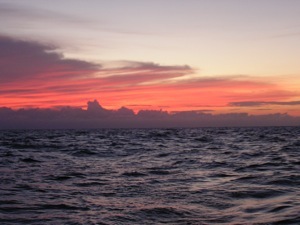
Generally squall lines are forecast and you can see the black lines coming either with your eyes or on the radar in plenty of time to prepare – we always reef early when there’s any question. When at anchor, we always remove as much windage as possible – take the kayaks out of their racks on the rail and tie them to the deck, and take appropriate action with the dinghy – usually leaving it hanging on the hip of the boat, occasionally lifting it aboard and putting the outboard on the rail. We have been known to leave it on a cable behind the boat, but we don’t like to do this for two reasons — one, torrential rains can fill the dinghy quickly – if it’s in the water, someone has to climb in and bail – if it’s hanging we simply remove the drain plug; second, if the boat were to drag and the dinghy is in the water, it’s one more thing to deal with and under those circumstances (only happened once) we don’t need any other distractions – and the last thing you would need is to catch the dinghy tie line in the main boat’s prop!!!
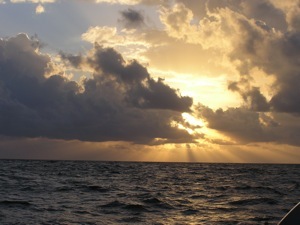
In over 2 years of chartering and 10 years and almost 10,000 miles cruising aboard Winterlude, there are only 5 major incidents that qualify as “storms” (one was a strong strong high pressure after a low pressure). That translates to less than one incident per six month cruising season. That’s not to say we don’t have cold fronts every year – see tomorrow’s (Tues) post, “Anchoring for a Norther”. So while storms do happen despite our best efforts to avoid them with good weather forecasting, they occupy a disproportionate place in most cruisers’ “fear factors”, including mine!
Anyone out there have a good storm story? Leave a comment and share! THX! Jan
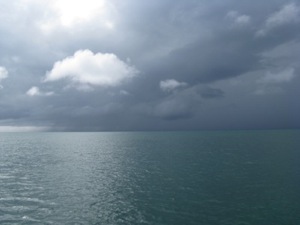










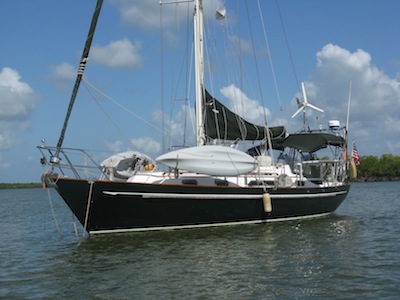
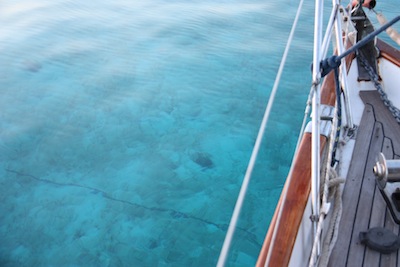
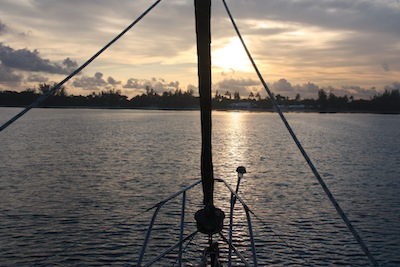
Hi Folks,
Excellent article, I also read your 11 anchoring tips for northers, great advice. We have been coastal sailing for many years and have now sold our house and moved into an apartment in preparation to permanently throw off the lines in 2017 when we retire. I really appreciate people who have been out there sharing their experience with us newbies:) Maybe we will meet up someday. Thanks again.